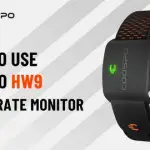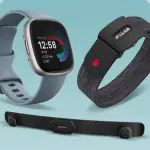Discover how heart rate monitors provide precision and comfort in your fitness routine, optimizing workouts and enhancing overall training experiences for better results.
A heart rate monitor is more than a gadget; it’s a gateway to understanding how your body responds to various exercise intensities. Heart rate monitoring goes beyond tracking steps or calories burned; it measures the cardiovascular effort you exert, which is crucial for designing workouts that target specific goals. Whether you’re aiming to build endurance, increase aerobic capacity, or optimize fat burning, heart rate data provides the feedback needed to improve consistently and avoid overtraining or undertraining.
Why Heart Rate Matters for Your Fitness Goals
Knowing your heart rate zones helps personalize your workouts and make them more effective. Different heart rate zones correspond to different levels of exertion and training benefits, from low-intensity fat-burning zones to high-intensity anaerobic zones. For those striving to reach peak fitness or recovery, understanding these zones can be transformative. Additionally, heart rate data can help you measure improvements over time, such as a lower resting heart rate or quicker recovery after intense activities—both indicators of improved cardiovascular health.

The Role of Heart Rate Monitors in Tracking Progress
Heart rate monitors provide data-driven progress tracking that offers insights beyond just completing workouts. Over time, consistent monitoring helps identify trends, such as improved recovery rates and reduced time to reach peak heart rate zones, signaling better endurance. For athletes, heart rate monitors can act as a guide, offering real-time information that ensures each workout meets specific goals and training thresholds. Long-term data allows for refined workout planning, supporting sustainable fitness gains and helping users visualize their progress.
Benefits of Investing in a Premium Heart Rate Monitor
While basic heart rate monitors serve their purpose, premium options offer expanded functionality, delivering a more holistic view of health and performance. Premium heart rate monitors are built with advanced sensors that provide higher accuracy, more data points, and user-friendly design features. For anyone committed to health, a premium monitor is an invaluable asset that enhances training efficiency and helps maintain motivation over time.
What Sets Premium Heart Rate Monitors Apart?
Enhanced Accuracy for Reliable Data
Precision is a hallmark of premium heart rate monitors. Advanced models use high-quality sensors, such as dual-frequency tracking, that adapt to various conditions, whether during high-intensity intervals or extended endurance sessions. With accurate data, users are better equipped to gauge exertion levels and avoid under- or overtraining, making premium monitors a smart choice for those looking to optimize every workout.
Comfort Features for Prolonged Use
Wearability is essential in a device used during physical activity. Premium monitors focus on lightweight, breathable materials that minimize discomfort and prevent chafing. Whether worn on the chest, wrist, or arm, these monitors offer ergonomic designs and flexible materials that stay secure and comfortable. For those who wear heart rate monitors daily or during long-distance activities, this level of comfort is a must.
Advanced Metrics and Data Insights
Premium monitors go beyond simple heart rate tracking, offering data points like VO2 max, heart rate variability (HRV), and stress levels. These metrics provide a more comprehensive view of physical health and allow users to make well-informed training adjustments. For athletes and fitness enthusiasts who want to optimize every aspect of their training, these advanced features add invaluable context to their workouts.

Types of Heart Rate Monitors: Finding Your Fit
Wrist-Based Monitors vs. Chest Straps
Wrist-based heart rate monitors are convenient, making them a favorite for general fitness use. However, chest straps are renowned for superior accuracy, especially during high-intensity activities. Choosing between the two depends on personal preference, comfort, and the types of activities. For those requiring absolute precision, chest straps are often preferred, while wrist monitors offer a balance of ease and versatility.
The Growing Popularity of Ear and Armband Monitors
Ear and armband monitors present an alternative for those who find wrist or chest-based options uncomfortable. These types of monitors offer a combination of accuracy and comfort, and they’re less likely to slip during intense activities. For moderate to high-intensity training, ear and armband monitors can be practical choices, especially in sports like cycling and rowing where free arm movement is essential.
Choosing the Right Monitor Based on Activity Type
The best heart rate monitor is one suited to your primary activities. For example, swimmers and endurance athletes often opt for water-resistant chest straps, while casual fitness enthusiasts may prefer the convenience of wrist monitors. Selecting a monitor that aligns with your main activities ensures both comfort and functionality, ultimately leading to a better fitness experience.
Key Features to Look for in a Premium Heart Rate Monitor
Precision Tracking for Optimal Performance
Precision tracking enables users to tailor their workouts and maintain intensity without risk of overtraining. For those focused on achieving performance milestones, accurate readings of heart rate fluctuations during various exercise phases allow for fine-tuning. By choosing a premium monitor with reliable tracking, users can confidently stay within the desired heart rate zones.
Comfort-Focused Design and Wearability
The materials and design of premium monitors are engineered for comfort. High-quality straps and ergonomic shapes prevent discomfort during long workouts. Whether in hot conditions or multi-hour endurance events, comfort is key to keeping the monitor secure and unobtrusive. This is especially important for those using their monitor daily or during rigorous activities.
Battery Life and Charging Capabilities
Battery life is a vital feature for users engaging in prolonged activities. Many premium monitors are equipped with long-lasting batteries or quick-charging options, ensuring reliable performance. Whether embarking on a multi-day hike or marathon training, extended battery life helps prevent interruptions, offering peace of mind and continuous monitoring.
Exploring Connectivity and Compatibility Options
Premium heart rate monitors often feature seamless connectivity with fitness apps, smartphones, and other wearable devices. Bluetooth and ANT+ compatibility allows users to sync with third-party platforms, enabling detailed data analysis and tracking. Connectivity is essential for users who rely on comprehensive data integration to optimize their workouts.
Accuracy vs. Comfort: Balancing Priorities
When Accuracy Is the Top Priority
For those driven by precise data, accuracy is critical, and chest straps generally deliver the most reliable readings. High-accuracy monitors are preferred for intense sessions where rapid changes in heart rate require real-time tracking, ensuring users stay within optimal zones and gain maximum benefit from each session.
For Comfort Seekers: Lightweight and Breathable Options
Comfortable monitors with lightweight, breathable designs are ideal for users prioritizing ease of wear. Wrist monitors and armbands offer flexibility and are suitable for moderate activities, providing reliable tracking without the pressure of a chest strap. Comfortable options enhance the experience and ensure consistent usage.
How to Combine Both Accuracy and Comfort
For those wanting both accuracy and comfort, using different monitors for various activities is a practical approach. A chest strap may be ideal for high-intensity workouts, while a wrist monitor suits low-impact activities. This balance allows users to adapt monitoring styles based on comfort needs and performance requirements.
The Role of Advanced Technology in Premium Monitors
Optical vs. Electrical Heart Rate Monitoring Technology
Heart rate monitors primarily use optical or electrical sensors. Optical sensors, commonly found in wrist monitors, detect blood flow changes, while electrical monitors, often in chest straps, measure heart rate directly from electrical activity. Each technology has unique advantages, allowing users to choose based on their accuracy needs.
Impact of AI and Machine Learning on Data Precision
AI and machine learning significantly enhance data precision in modern monitors. These algorithms adapt to the user’s unique physiological traits, reducing inaccuracies. Through continual learning, premium monitors offer personalized and more accurate readings, improving the user experience over time.
Health Insights Beyond Heart Rate: VO2 Max, Stress Levels, and More
Premium monitors deliver a wealth of health metrics beyond heart rate, including VO2 max, lactate threshold, and stress levels. These insights offer a complete view of fitness and aid in creating well-rounded training programs that cater to physical and mental well-being.
Connectivity Essentials for Modern Heart Rate Monitors
Bluetooth vs. ANT+ Compatibility
Bluetooth and ANT+ are the primary connectivity options, with each offering unique advantages. Bluetooth connects directly to phones and apps, while ANT+ enables data sharing across multiple devices simultaneously, benefiting users who rely on several fitness tools for tracking and analysis.
Syncing with Fitness Apps and Smart Devices
Premium monitors integrate seamlessly with popular fitness apps like Strava, Garmin Connect, and Apple Health. These apps enable users to set goals, track progress, and share achievements, creating a more holistic experience that enhances motivation and accountability.
Water Resistance and Durability: A Must for Active Lifestyles
Durability is a crucial feature for active users. Premium heart rate monitors are designed to withstand sweat, rain, and immersion, ensuring reliability across various conditions. Water resistance is especially important for those who swim or train outdoors.
How Premium Heart Rate Monitors Enhance Training
Real-Time Feedback for Immediate Adjustments
Real-time feedback enables users to make on-the-spot adjustments, optimizing each session. Immediate data on heart rate zones helps users adapt their intensity levels, ensuring they stay within the desired zone for maximum effectiveness and safety.
Tracking Recovery and Optimizing Rest Days
Heart rate data can also track recovery, providing insights into overtraining or the need for rest days. Premium monitors help users understand their body’s recovery needs, allowing for more efficient and balanced training schedules that support sustained progress.
Heart Rate Zone Monitoring for Targeted Workouts
Heart rate zone monitoring helps users target specific workout goals, such as aerobic capacity or endurance building. By tailoring workouts to precise zones, users can achieve desired results faster and with a more structured approach
FAQ
What features should I look for in a premium heart rate monitor?
Look for features such as accurate heart rate tracking, Bluetooth compatibility, GPS, and advanced metrics like heart rate variability (HRV) and VO2 max.
How do I determine if a heart rate monitor is accurate?
Accuracy can be assessed by checking user reviews, looking for clinical validation, and comparing results with a trusted monitor during workouts.
What is the difference between wrist-based and chest strap monitors?
Wrist-based monitors are convenient and often have additional fitness tracking features, while chest straps provide more accurate heart rate data, especially during high-intensity exercise.
Can I use a heart rate monitor for swimming?
Many premium heart rate monitors are water-resistant and designed for swimming, offering real-time heart rate tracking even underwater.
How do heart rate monitors track recovery and training progress?
They monitor heart rate fluctuations during workouts and rest, helping to assess recovery time, workout intensity, and overall cardiovascular fitness.
Are premium heart rate monitors compatible with fitness apps?
Most premium monitors sync with popular fitness apps like Strava, MyFitnessPal, and Apple Health, allowing you to analyze and track your workouts easily.
What are the benefits of advanced metrics like VO2 max and HRV?
VO2 max provides insights into aerobic fitness levels, while HRV indicates how well your body recovers and responds to stress, helping optimize training routines.
How do I choose a heart rate monitor based on my fitness goals?
Consider your specific fitness objectives, such as weight loss, endurance training, or competition, and select a monitor that provides the necessary metrics and features to support those goals.




